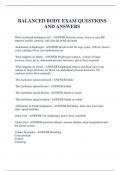BALANCED BODY EXAM QUESTIONS
AND ANSWERS
What can breath techniques do? - ANSWER Decrease stress, lower or raise BP,
improve aerobic capacity, and calm the mind and spirit
attachment of diaphragm - ANSWER Inside of the rib cage, spine, 12th rib, lowest
costal cartilage fibers, and xiphoid process
What happens on inhale - ANSWER Diaphragm contacts, volume of lungs
increase, draws air in, abdominal pressure increases, pelvic floor responds
What happens on exhale - ANSWER Diaphragm relaxes and dome moves up,
volume of lungs decrease, air flows out, abdominal pressure decreases, TA
contracts, pelvic floor responds
This facilitates spinal extension - ANSWER Inhale
This facilitates spinal flexion - ANSWER Exhale
This facilitates lateral flexion - ANSWER Inhale or exhale
This facilitates spinal rotation - ANSWER Inhale or exhale
4 Elements of Trunk Integration - ANSWER Breathing, inner unit, four outer
units, spinal mobility
Inner Unit - ANSWER TA, diaphragm, pelvic floor, multifidi
Outer Unit - ANSWER posterior oblique, anterior oblique, deep longitudinal and
the lateral system
Pilates Principles - ANSWER Breathing
Concentration
Control
Centering
, Balanced muscle development
Precision
Rhythm/flow
Relaxation
Whole body movement
Movement principles - ANSWER Whole body movement, trunk integration,
upper body training, lower body training, restoration/mobility
Deep Longitudinal System - ANSWER Erector spinae, biceps femoris,
sacrotuberus ligament, gastroc, plantar fascia
Anterior Oblique Sling - ANSWER Serratus anterior, external oblique, opposite
internal oblique, opposite adductor
Posterior Oblique Sling - ANSWER Lats, opposite glute max
Lateral System - ANSWER QL, Adductors, abductors
Action of Deep Longitudinal System - ANSWER Extension; keep body upright
against gravity; when activated unilaterally it does lateral flexion
Action of Lateral System - ANSWER Add/abd of the hip and up slip and Down
slip of the pelvis
Action of posterior oblique sling - ANSWER Extension, partners with AOS for
rotation and lateral flexion when activated unilaterally
Action of Anterior Oblique Sling - ANSWER Flexion, rotation a b/w rib cage and
pelvis when activated unilaterally
action of multifidus - ANSWER bilateral: extend vertebral column
unilateral: laterally flex and rotate vertebral column
Support spine at deepest level
action of transversus abdominis - ANSWER Provides structure to abdominal wall
action of diaphragm - ANSWER Prime mover of inspiration; flattens on
contraction
An exhale can be used to activate the core, creating lumbar stability




